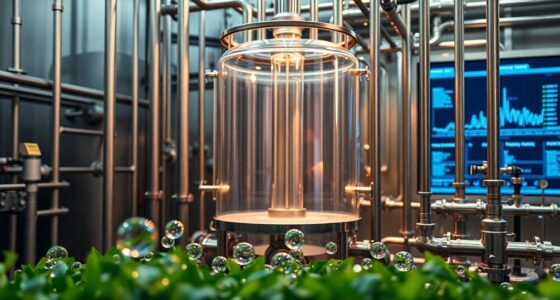Ocean acidification occurs when excess CO2 from human activities like burning fossil fuels dissolves into seawater, lowering its pH and disrupting marine chemistry. This makes it harder for corals and marine organisms to build calcium carbonate skeletons, leading to coral bleaching and habitat loss. As reefs decline, marine biodiversity and fish populations suffer, impacting ecosystems and human livelihoods that depend on them. If you want to understand how these changes affect the future of our oceans, keep exploring.
Key Takeaways
- Excess CO2 from burning fossil fuels dissolves into seawater, lowering pH and causing ocean acidification.
- Acidification hampers corals’ ability to build calcium carbonate skeletons, leading to bleaching and habitat loss.
- Declining coral reefs reduce marine biodiversity and disrupt food chains, impacting fisheries and ecosystem resilience.
- Broader ecosystem health suffers, increasing vulnerability to stressors like warming temperatures and pollution.
- Mitigation involves reducing carbon emissions and protecting marine environments to slow acidification effects.

Ocean acidification occurs when the oceans absorb excess carbon dioxide from the atmosphere, leading to a decrease in seawater pH levels. As CO2 levels rise due to human activities like burning fossil fuels and deforestation, more of this greenhouse gas dissolves into the ocean, disrupting the delicate balance of marine chemistry. One of the most visible and alarming effects of this process is coral bleaching. When water becomes more acidic, corals struggle to maintain their calcium carbonate skeletons, which are essential for their growth and survival. The stress from acidification causes corals to expel the symbiotic algae living within their tissues, leading to bleaching events that leave corals pale and vulnerable. Without the algae, corals lose their primary source of energy, making it difficult for them to recover and grow. Over time, repeated bleaching episodes weaken entire coral reef systems, which are among the most diverse and productive ecosystems on Earth.
Coral reefs serve as indispensable habitats for countless marine species, supporting an incredible diversity of marine biodiversity. As ocean acidification intensifies, the health of these reefs declines, resulting in a loss of habitat for fish, mollusks, crustaceans, and other marine organisms. The decline in coral health affects the food chain at multiple levels, disrupting ecosystems and threatening the survival of many species. You might not see the immediate impact in your daily life, but the decline of coral reefs and the loss of marine biodiversity have far-reaching implications. Fisheries that depend on reef species could diminish, affecting food security for millions of people. Additionally, the decline in biodiversity reduces the resilience of marine ecosystems, making them more susceptible to other stressors like warming temperatures and pollution.
Understanding the connection between ocean acidification and coral bleaching highlights the importance of addressing carbon emissions. The more CO2 we emit, the more we threaten these indispensable ecosystems. Efforts to reduce greenhouse gases can help slow acidification, giving corals and marine biodiversity a better chance to adapt or recover. Protecting marine environments, establishing marine protected areas, and reducing pollutants are essential steps in mitigating the impacts. By recognizing the significance of coral reefs and marine biodiversity, you become part of the solution—supporting policies and practices that aim to preserve these ecosystems for future generations. The health of the oceans depends on our actions today, and preventing further acidification is fundamental for maintaining the rich, vibrant life beneath the waves.
A key strategy in combating these impacts is promoting the adoption of whole-house water filtration systems, which can help reduce pollutants and protect local marine environments from runoff and contamination.
Frequently Asked Questions
How Does Ocean Acidification Affect Deep-Sea Ecosystems?
You might not realize it, but ocean acidification considerably impacts deep-sea ecosystems by threatening biodiversity. As acidity increases, carbonate dissolution accelerates, making it harder for organisms like corals and shellfish to build and maintain their calcium carbonate structures. This decline in habitat complexity reduces deep-sea biodiversity, disrupting food webs and ecological balance, ultimately threatening the health and resilience of these fragile ecosystems.
Can Ocean Acidification Be Reversed or Stopped?
Like turning back the tide, reversing ocean acidification isn’t straightforward, but it’s possible. You can support geoengineering solutions and carbon capture initiatives that reduce CO2 emissions, helping slow or halt the process. While full reversal remains challenging, these efforts, combined with reducing your carbon footprint, can make a difference. Acting now is essential, as the ocean’s health depends on your commitment to these innovative strategies.
What Regions Are Most Vulnerable to Acidification Impacts?
You should know that coral reefs and polar regions are the most vulnerable to acidification impacts. Coral reefs, due to their calcium carbonate structures, are highly sensitive, risking widespread damage. Polar regions face increased acidification because cold waters absorb more CO2, threatening marine life. These areas require urgent protection efforts, as their vulnerability can lead to significant ecological and economic consequences, affecting global biodiversity and fisheries.
How Does Acidification Influence the Fishing Industry?
You’ll see acidification negatively impact the fishing industry by causing fisheries decline, which reduces fish populations essential for commercial and local fishing. As shell-forming species struggle, catches decrease, leading to economic losses for fishermen and communities dependent on fishing. This environmental change threatens livelihoods, increases food insecurity, and disrupts supply chains, making it vital to address ocean acidification and protect marine resources for future sustainability.
Are There Any Natural Processes That Mitigate Ocean Acidification?
Natural processes like marine buffering help mitigate ocean acidification. You should know that marine buffering involves the ocean’s capacity to neutralize excess acidity, mainly through the dissolution of calcium carbonate from shells and skeletons of marine organisms. This process helps stabilize pH levels, but it’s not enough to offset the rapid acidification caused by increased CO2. Protecting calcium carbonate-producing organisms is essential for maintaining this natural buffer system.
Conclusion
You might think ocean acidification is just a natural process, but scientific evidence shows human activities markedly accelerate it. While some skeptics argue ecosystems could adapt over time, recent studies suggest many marine species struggle to cope with rapid pH changes. The theory that oceans can fully recover on their own ignores the ongoing damage and the urgency to reduce carbon emissions. Addressing this issue now is essential to protect marine life and preserve our planet’s health.










